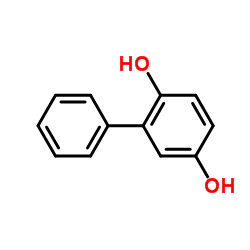DNA adduct formation by o-phenylphenol metabolite in vivo and in vitro.
K Ushiyama, F Nagai, A Nakagawa, I Kano
Index: Carcinogenesis 13(8) , 1469-73, (1992)
Full Text: HTML
Abstract
[U-14C]o-Phenylphenol (OPP) was found to bind covalently to calf thymus DNA during a 60 min incubation in the presence of microsomes, but not in their absence, indicating that metabolic conversion of the parent compound, OPP, to an activated form is essential. Postlabeling analysis with bladder DNA of rats fed a diet containing 2% OPP for 13 weeks revealed one major adduct on TLC. In an in vitro postlabeling experiment with calf thymus DNA, both of the major metabolites of OPP, phenylhydroquinone (PHQ) and phenylbenzoquinone (PBQ), formed adducts, but no adducts were observed with OPP. The chemical structure responsible for adduct formation is thought to be the PHQ semiquinone radical intermediate formed during interconversion between PHQ and PBQ. When the oligonucleotides, pd(A)12-18, pd(C)12-18, pd(G)12-18 and pd(T)12-18, were used in vitro, only pd(G)12-18 gave TLC-detectable adducts on treatment with PHQ and PBQ. The covalent binding appears to be rather specific to guanine residues. These results suggest that covalent binding of the OPP metabolite is one of the underlying events in OPP-induced carcinogenesis in rats.
Related Compounds
| Structure | Name/CAS No. | Molecular Formula | Articles |
|---|---|---|---|
 |
2,5-Biphenyldiol
CAS:1079-21-6 |
C12H10O2 |
|
Cytotoxic effects of phenyl-hydroquinone and some hydroquino...
1992-09-25 [Biochem. Pharmacol. 44(6) , 1059-65, (1992)] |
|
Tuning surface hydrophilicity/hydrophobicity of hydrocarbon ...
2016-03-15 [J. Colloid. Interface Sci. 466 , 168-77, (2016)] |
|
Metabolism of phenylhydroquinone by prostaglandin (H) syntha...
1991-01-01 [Carcinogenesis 12(1) , 145-9, (1991)] |
|
The inhibition of phenylhydroquinone-induced oxidative DNA c...
2000-02-01 [Biol. Pharm. Bull. 23(2) , 199-203, (2000)] |
|
Metabolites of the biocide o-phenylphenol generate oxidative...
2000-01-01 [Arch. Toxicol. 73(10-11) , 607-10, (2000)] |